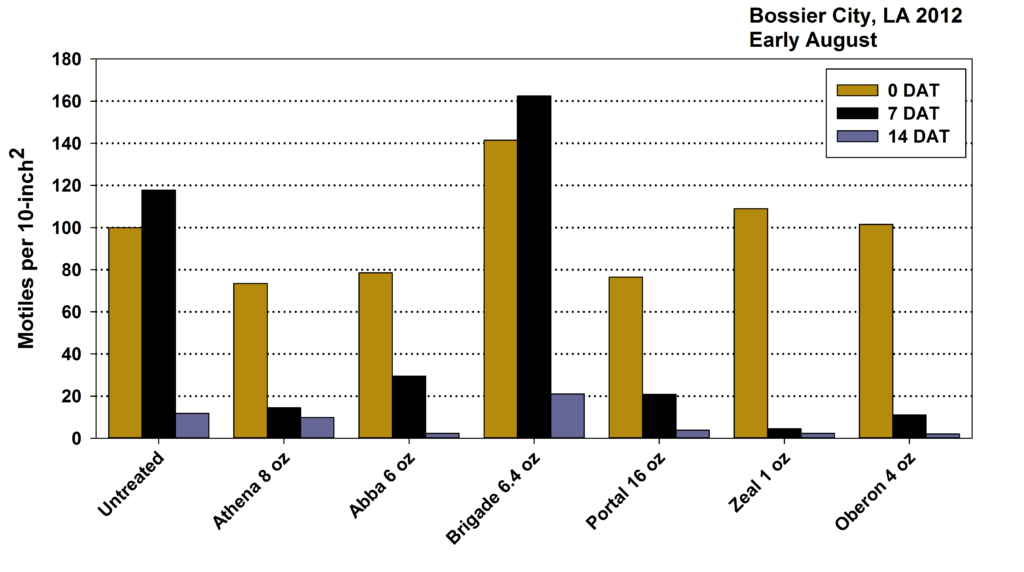by Dr. David L. Kerns, Professor and IPM Coordinator
Crops have been suffering from intense heat and lack of moisture over the past 2 weeks but we are hoping for some relief over the next 3 to 4 days. The high temperatures and lack of moisture have contributed significantly to some severe pest problems, namely cotton fleahoppers and spider mites. As vegetation in the landscape dries up, these pests are forced to seek other food sources and have moved into cotton throughout much of the Blacklands and the River Bottom. In our tests we have been getting as much as 200% infestation of fleahoppers and insecticides are only providing control about 5 to 7 days control (Figure 1). With the continual influx of adults we really aren’t seeing much differences among the insecticides we are testing, but based on nymph counts it looks like the Centric and those containing Imidacloprid (Admire) are giving slightly better residual control. Transform looks good also but is currently only labelled with a Section 18 emergency exemption for use on Lygus.
Spider mites are popping up everywhere and I have seen some significant damage in the dryland cotton. If you are seeing 30-40% of plants with some leaf reddening a treatment is justified. If you are at threshold use a good miticide like abamectin at (8-10 fl-oz/ac of the 0.15 EC or 4-5 fl-oz/ac of the SC formulation), Zeal at 1 oz/ac, Portal at 1-2 pt/ac or Oberon 4 SC at 5-6 fl-oz/ac. I have heard that some people are putting out Dimethoate or Bifenthrin as a preventative for spider mites. I do not recommend this practice. These products will sometimes offer some knockdown and early suppression, but in most cases the mite population will resurge right back to where they were or higher. Figures 2 & 3, demonstrate the lack of mite efficacy with bifenthrin (Brigade) or that product mixed with Dimethoate of Chlorpyrifos (Nufos). Lastly, on mites if you need to make an herbicide application and your cotton is Liberty Link, consider using Liberty over Glyphosate if you have mites present but not enough to justify a dedicated miticide. Liberty is a curious herbicide and actually has some miticidal properties (Figure 4). Liberty is not labelled as a miticide, but the added value of its activity on mites is nice.
Bollworms have been exceptionally heavy with some of our pheromone traps running >200 moth captures per night. We are seeing 2-3 large worms per corn ear in DoublePro, TriplePro and SmartStax Bt corn. So far Vip corn is very clean. We have not yet run Bt bioassays on these populations but based on field observations I suspect they are resistant to Cry1F, the Cry1A toxins and the Cry2A toxins. Our dual gene Bt cotton varieties are thus at risk. We are also picking them up in milo and a few in non-vip cotton fields. Additionally, we have been evaluating our bollworm moth catches for pyrethroid resistance. In late May and early June we were picking up about 15% pyrethroid resistance, but this week it jumped to 30% with 15% of those showing very high pyrethroid resistance. For cotton I suggest sticking with Prevathon or Besiege, but in milo if the population is not severe and you can catch small worms, a pyrethroid will probably be fine.
Lastly, we are seeing a sprinkling of sugarcane aphids. Not enough to be concerned with, but definitely worth keeping an eye on.
If you have any questions or comment feel free to contact me, email: dlkerns@tamu.edu, cell phone: 318-439-4844.

Professor & IPM Extension Specialist
Texas A&M AgriLife Extension Service
Department of Entomology
College Station, TX 77843-2475
dlkerns@tamu.edu
979.845.2516



